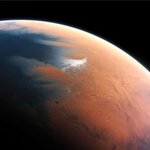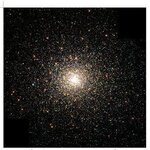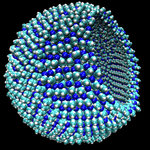Space

Most of the times we have looked at Uranus, it has seemed to be a relatively calm place. Well, yes its atmosphere is the coldest place in the solar system.
But, when we picture the seventh planet in our solar system invariably the image of a calming blue hazy disc that the spacecraft Voyager 2 took in 1986 comes to mind.
However, all we have previously known about the atmosphere of Uranus has been ’thrown to the wind’ with observations made last year.
In August 2014 a group led by Imke de Pater pointed the Keck telescope at Uranus and were a little bit surprised to see storms raging.
It…

Four billion years ago, a young Mars had enough water to bury its whole surface under 400 feet of ocean, but it is more likely that, as on Earth, it pooled. In the case of Mars, it probably formed an ocean occupying almost half of Mars’s northern hemisphere, reaching a mile deep in some places.
This new finding is based on detailed observations of two slightly different forms of water in Mars’s atmosphere. One is the familiar form of water, made with two hydrogen atoms and one oxygen, H2O. The other is HDO, or semi-heavy water, a naturally occurring variation in which one hydrogen atom…

Undefined matter under the envelope of "dark matter" makes up over 80% of the universe - but it has never been directly detected.
But the search is on to narrow it down and a new paper has computationally set limits to the properties of one of the particles which might be identified as dark matter: axions. Due to the high temperature inside stars, photons can turn into axions that escape to the exterior, carrying energy with them.
The simulation indicates that the emission of axions can significantly diminish the time for the central combustion of helium, the so called HB (Horizontal…

The Z machine generates electric currents of up to 20 million amps, to shoot aluminium projectiles at iron targets, replicating the impacts of early asteroids. CC BY
New experiments show that the asteroids that slammed into Earth and the moon more than 4 billion years ago were vaporized into a mist of iron. The findings, published in Nature Geoscience, suggest that the iron mist thrown up from the high velocity impacts of these asteroids traveled fast enough to escape the moon’s gravity, but stayed gravitationally stuck on more massive Earth. And these results may help explain why the…

A new type of methane-based, oxygen-free life form can metabolize and reproduce similar to life on Earth.
This hypothetical cell membrane, modeled by a team of researchers, is composed of small organic nitrogen compounds and capable of functioning in liquid methane temperatures of 292 degrees below zero - necessary for a harsh, cold world - specifically Titan, the giant moon of Saturn, a planetary body awash with seas not of water, but of liquid methane, Titan could harbor methane-based, oxygen-free cells.
On Earth, life is based on the phospholipid bilayer membrane, the strong, permeable,…

3753 Cruithne's wacky orbit around the Sun. Image: YouTube, CC BY-SA
We all know and love the moon. We’re so assured that we only have one that we don’t even give it a specific name.
It is the brightest object in the night sky, and amateur astronomers take great delight in mapping its craters and seas.
To-date, it is the only other heavenly body with human footprints.
What you might not know is that the moon is not the Earth’s only natural satellite. As recently as 1997, we discovered that another body, 3753 Cruithne, is what’s called a quasi-orbital satellite of Earth. This simply means…
Ceres is the largest object in the asteroid belt, and NASA’s Dawn spacecraft will arrive at this dwarf planet on March 6, 2015. Pluto is the largest object in the Kuiper belt, and NASA’s New Horizons spacecraft will arrive at this dwarf planet on July 15, 2015. Launch of NASA’s Dawn spacecraft from Cape Canaveral Air Force Station, Florida, September 27, 2007. Get ready, Ceres! NASA
These two events will make 2015 an exciting year for solar system exploration and discovery. But there is much more to this story than mere science. I expect 2015 will be the year when general…

What is hiding in the large disk of gas and dust encircling the 20 million-year-old star Beta Pictoris?
In 1984 Beta Pictoris was the very first star discovered to be surrounded by a bright disk of dust and debris. Since then, Beta Pictoris has been an object of intense scrutiny with Hubble and ground-based telescopes.
Thanks to a new image, there is a better indication of what is going on in there - it traces the disk to within about 650 million miles of the star. Beta Pictoris is the only star to date where astronomers have detected an embedded giant planet in a directly-imaged…

Plumes that reached over 100 miles above the surface of Mars, reported by citizen scientist astronomers in March and April 2012, continue to puzzle scientists. In the past, similar events had been seen, but only up to around 50 miles.
The features developed in less than 10 hours, covering an area of up to 1000 x 500 kilometers, and remained visible for around 10 days, changing their structure from day to day. None of the spacecraft orbiting Mars saw the features because of their viewing geometries and illumination conditions at the time but citizen scientists and their telescopes…

Jupiter’s icy moon Europa puzzles astrobiologists and sparks the imagination of extraterrestrial life seekers.
It is believed that the moon has a subsurface ocean of liquid water, where life could possibly be similar to microbial life forms on Earth.
The likely presence of liquid water has ignited persisting calls to send a probe there. Currently NASA and ESA plan their own missions to the potentially habitable moon. Europa Clipper mission has just got approved for $30 million in the 2016 NASA budget and ESA’s Jupiter Icy Moon Explorer (JUICE) is scheduled for launch in 2022.
But an…